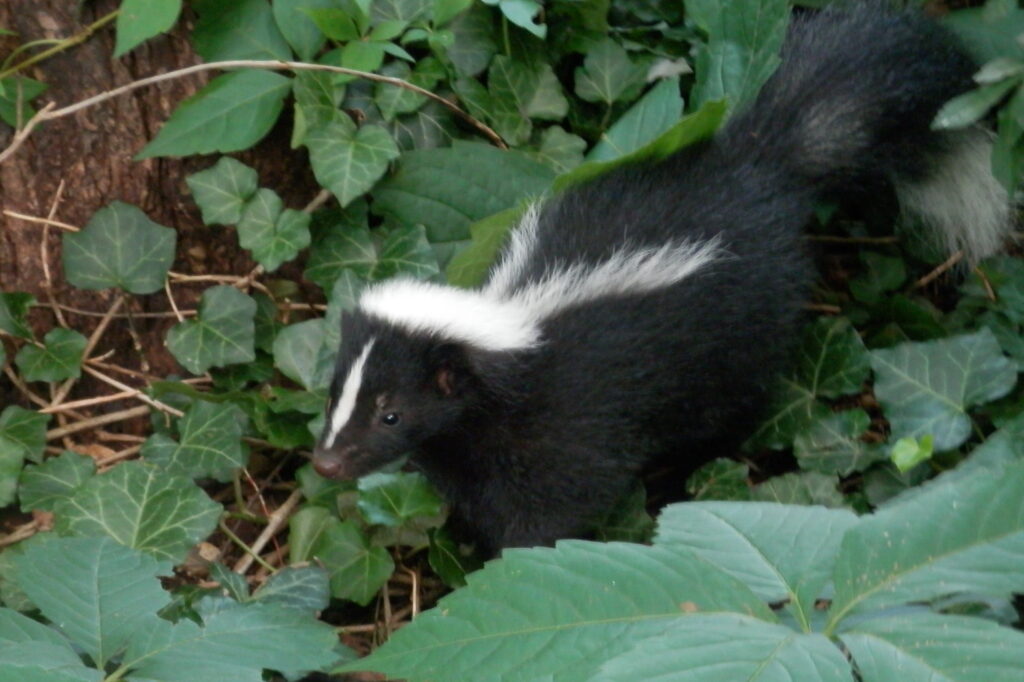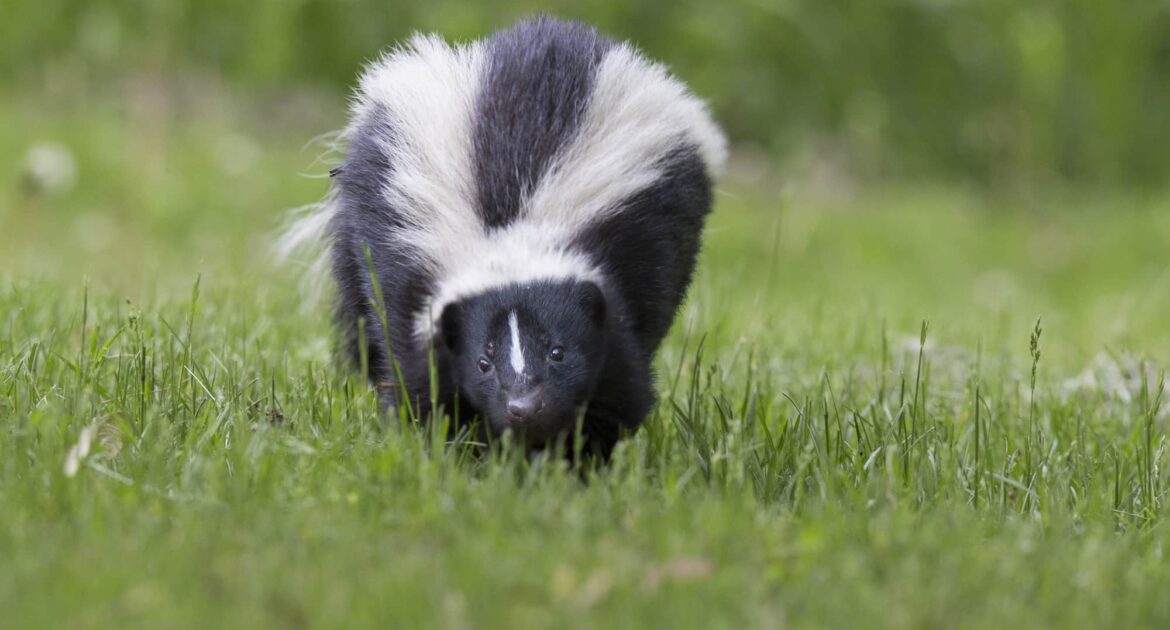If you’re a homeowner, you’ve likely had your fair share of unwanted, furry neighbors. Skunks, in particular, can be bothersome – and whiffy – houseguests.
Fortunately, there is a safe and effective solution, but you may think differently. In the bustling city of Minneapolis, a DIY approach to skunk removal may seem tempting, but it’s fraught with danger.
This blog will uncover the hidden risks of trying to do-it-yourself, revealing why an expert’s touch is needed – particularly ours.
Need to know how to keep skunks away? You’ll discover the signs pointing to a skunk intrusion, understand their behavioral nuances, confront the biggest threats of DIY removal, learn how professional wildlife control can keep you safe, and finally, see how we are equipped to secure your home against future invasions. The aim? To leave you knowledgeable, prepared, and above all, skunk-free!
What are the Common Signs of a Skunk Infestation in Minneapolis Homes?
As a homeowner, it is crucial to attentively observe your surroundings and notice any changes that may suggest possible wildlife invasion. In the case of skunks, several signs may indicate an infestation. You should be on the lookout for these signs, as early detection can prevent further problems.
- Distinctive Odor: One of the most evident signs of a skunk infestation is a strong, distinctive odor. When threatened, skunks can produce a foul-smelling spray which is hard to ignore and difficult to remove. Even at a notably low intensity, this smell strongly suggests you may have a skunk problem.
- Holes in the Yard: Skunks are known for their digging habits. They often burrow in search of grubs and worms, their primary source of nourishment. Thus, if you suddenly notice small, cone-shaped holes or disturbed soil in your yard, it may be a sign of skunk invasion.
- Structural Damage: Similarly, skunks can also create large burrows under buildings, patios, or decks. Their burrowing habit can lead to foundational damage in your home. Any unexplained structural damage, therefore, should be scrutinized for possible skunks.
- Skunk Tracks: Detecting skunk footprints in or around your property can be another revealing sign. Skunks have distinctive five-toed footprints that can be easily identified. These prints often lead to their burrows, hinting at an infestation.
- Skunk Droppings: Although not the most pleasant sign, finding skunk droppings around your yard or near garbage bins can indicate their presence. Skunk droppings have a specific look – they are typically cylindrical in shape, about half an inch in diameter, and contain undigested insect parts.
If you observe one or more of these signs, don’t rush into action. Skunks pose hazards beyond their smell. They can feel threatened easily and, when so, might resort to biting or spraying their odorous discharge. These defensive actions can expose you to potential diseases or undesired consequences. Hence, consulting professionals like us, your trusted wildlife control technicians is best.
How Do Skunks React When They Feel Threatened?
When it comes to understanding the behavior of these black and white creatures, it’s important to note that skunks are typically docile and reluctant to use their potent under-tail weaponry. Yet, when they feel threatened, their behaviour changes drastically, suggesting that you should rethink your DIY skunk removal approach.
The initial reaction of a skunk when it feels threatened ranges from mild to severe. Skunks initiate a series of warning signs which may include:
- Raising their tail
- Stomping their feet
- Hissing
- Twirling in place
These are typically clear signals to back off. If ignored, they escalate their defenses to the next level – spraying their notorious foul-smelling liquid. This defensive spray has a range of up to ten feet, and is not only unpleasant, but can cause severe discomfort and temporary blindness.
Note: Attempting a DIY skunk removal when these warning signs appear can lead to you, your family, or pets getting sprayed and inadvertently attracting more wildlife due to the lingering smell.
Furthermore, skunks are known carriers of harmful diseases, such as rabies. When they feel trapped or cornered, they could bite or scratch, posing another serious risk to anyone attempting DIY skunk removal.
In essence, attempting to handle these situations on your own can quickly transform a nuisance situation into a potentially hazardous one. This is why it’s imperative to let trained professionals like us handle skunk removal. We have the best strategies and tools to safely, effectively, and humanely manage any skunk infestation you may be dealing with, thereby lowering any risks involved.

What are the Top 10 Dangers Associated with DIY Skunk Removal?
Attempting to handle skunk removal yourself can lead to several dangers, some of which might not even cross your mind. Although DIY videos on the internet might make this task seem simple and harmless, the reality couldn’t be more different. Let’s shine a light on the top 10 dangers linked with DIY skunk removal:
- Unprotected Contact: Skunks carry various diseases like rabies, distemper, and leptospirosis that may harm your health. Without proper training and protective equipment, you risk exposure to these pathogens.
- Spray Injury: When a skunk feels threatened, it releases a foul-smelling spray which can cause temporary blindness and breathing difficulties in humans if it is directed at the face.
- Insufficient Skunk Proofing: With insufficient knowledge about advanced animal-proofing techniques, your DIY efforts in skunk-proofing your home may yield ineffective results, resulting in the return of these unwanted guests.
- Unforeseen Dangers: Skunks may take refuge in awkward places, such as under porches or inside crawlspaces. Venturing into these spaces without professional guidance might put you in risky situations.
- Unnecessary Trauma to Animals: Without appropriate handling techniques, you might stress out and traumatize the skunk, altering its behavior and making its removal even harder.
- Violation of Local Laws: Some local laws highly regulate wildlife handling. Removing skunks without being aware of these regulations can put you on the wrong side of the law.
- Incorrect Removal Methods: Using mothballs, ammonia, or smoke to induce skunks to leave can be harmful to them and is generally ineffective.
- Damage to Property: Untrained or improper removal attempts might result in considerable damage to your property.
- Potential for Injury: Climbing onto roofs or into other high places to reach skunks sets the stage for potential falls and accidents.
- Disturbance of Other Wildlife: Skunks often share habitats with other wild animals. Attempting to remove skunks could inadvertently disturb these animals, leading to additional conflicts with wildlife.
As evidenced by these points, it becomes clear that how to keep skunks away is best left to experts. With a risky task like this, enlisting the help of trained professionals who have the right knowledge, techniques, and equipment pays off in the long run.
Next, we’ll explore the ways a certified wildlife control technician can safely and humanely handle the job, keeping both you and the skunk safe from harm.
How Can a Wildlife Control Technician Help with Skunk Removal?
As a wildlife control technician at Skedaddle – or as we prefer to say, an expert in humane skunk removal – there are several ways we can assist you with your skunk problem.
- Understanding Skunk Behavior
Skunks are highly adaptable creatures with a keen survival instinct. This makes them unpredictable and potentially dangerous when they feel threatened. As a technician, we’re trained to understand skunk behavior and body language, allowing us to safely interact with these creatures. This way, we can avoid the hazards of improper handling, such as the animal releasing its offensive odor or biting in self-defense.
- Employing Humane Removal Strategies
In our work, we always prioritize humane and ethical approaches. For instance, we might use a one-way door technique to ensure skunks can exit your property without being able to return.
- Delivering Preventive Measures
We’re not only focused on evicting the skunks from your property but also on making sure they don’t come back. As part of our service, we provide advice and solutions on how to keep skunks away. This can include sealing potential entry points and removing food sources that might attract skunks in the first place.
- Providing Post-Removal Cleaning and Sanitation
Once the skunk has been successfully removed, your property may still carry signs of their presence like lingering smells or possible disease-carrying droppings. We offer thorough cleaning and sanitation procedures to ensure your home is safe, clean, and skunk-odor free once again.
Remember, skunk removal by a do-it-yourself approach not only risks potential exposure to wildlife diseases but could also create an ongoing cycle of skunk issues if not properly addressed. This is why you need a professional to help you handle these situations safely and effectively.
The Best Choice for Skunk Removal in Minneapolis
Managing a wildlife encounter, such as a skunk invasion, requires a nuanced approach. For the sake of your safety, the animal’s welfare, and the integrity of your property, it’s critical to rely on experienced professionals for skunk removal.
Through our reputable methods, we at Skedaddle not only guarantee humane removal but also devote ourselves to providing preventive measures and offering post-removal cleaning and sanitation services. Our expertise ensures you can return to the comfort of a skunk-free home and garden, with invaluable industry advice on how to keep skunks away in the future.
Why wait until the problem gets out of hand? Seize control of your skunk situation today. Contact us to request a quote and learn more about the comprehensive wildlife solutions we provide. You’ve come this far to learn about the hidden dangers of DIY skunk removal; it’s time to take the next step. Allow us to restore tranquility to your Minneapolis home.




